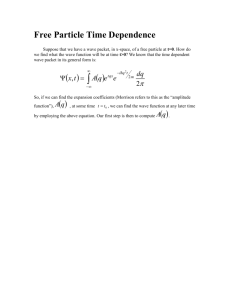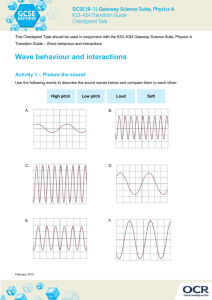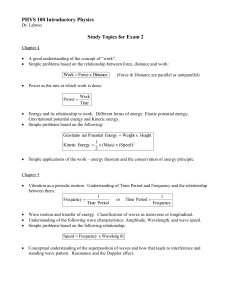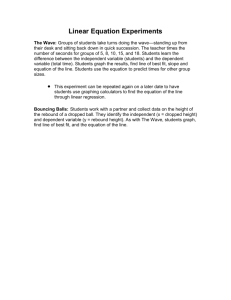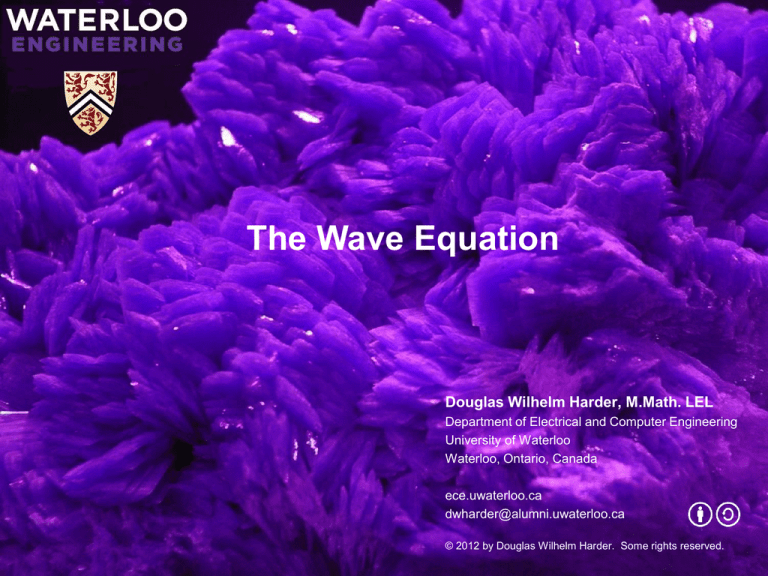
The Wave Equation
Douglas Wilhelm Harder, M.Math. LEL
Department of Electrical and Computer Engineering
University of Waterloo
Waterloo, Ontario, Canada
ece.uwaterloo.ca
dwharder@alumni.uwaterloo.ca
© 2012 by Douglas Wilhelm Harder. Some rights reserved.
Wave Equation
Outline
This topic discusses numerical solutions to the wave
equation:
– Discuss the physical problem and properties
– Examine the equation
– Approximate solutions using a finite-difference equation
• Consider numerical stability
• Examples
– What about Crank-Nicolson?
2
Wave Equation
Outcomes Based Learning Objectives
By the end of this laboratory, you will:
– Understand the wave equation
– Understand how to approximate partial differential equations
using finite-difference equations
– Set up solutions in one spatial dimension
– Deal with insulated boundary conditions
3
Wave Equation
Motivating Example
Suppose we start with a string at rest
4
Wave Equation
Motivating Example
Someone comes along and plucks the string
5
Wave Equation
Motivating Example
After letting go, the string begins to vibrate
– Energy is transferred to the air producing sound
6
Wave Equation
Motivating Example
Note that the string:
– Is at rest when it is a solution to Laplace’s equation
– Acceleration tends to be towards the solution of Laplace’s
equation
7
Wave Equation
Motivating Example
In addition, if we reduce the length of a string, the
vibrations increase:
– Halve the length of a string, double the frequency
– If a string of a certain length is middle C, a string of half the
length is one octave higher
8
Wave Equation
Motivating Example
Waves are not restricted to strings:
– The vibrations on the face of a drum
– The ripples on the surface of a pond
– The movement of light (microwaves, radio waves, etc.)
9
Wave Equation
The Wave Equation
The equation that describes the propagation of waves
under somewhat ideal circumstances is given by the
partial differential equation
2
2 2
u
c
u
2
t
where u(x, t) is a real-valued function of space and time
and c is the propagation speed of the wave
Sound in air at 20 oC
Light
c ≈ 343 m/s = 1234.8 km/h ≈ 1 km/3 s
c = 299 792 458 m/s
10
Wave Equation
11
The Wave Equation
For water in a deep ocean, the speed is proportional to
the square root of the wave length:
Wavelength
(m)
1
Speed
(m/s)
2.5
10
4
100
12.5
1000
39
140 km/h
Wave Equation
The Laplacian Operator
Notice if that u(x, t) already satisfies Laplace’s equation,
2u 0
then
or
2
2 2
u
c
u0
2
t
2
u0
2
t
That is, if a solution already satisfies Laplace’s equation,
it will not be accelerating
– In one dimension, if the string is already tight (a straight line), it
will not begin vibrating
– If it’s not moving, either, it will remain fixed
12
Wave Equation
Acceleration Proportional to Concavity
In one dimension, what does this equation mean?
2
2u
2 u
c
2
t
x 2
13
Wave Equation
Acceleration Proportional to Concavity
We can see this visually:
2
2u
2 u
c
2
t
x 2
– If the function u is concave up at (x, t), the acceleration of u over
time will be positive
u
0
t
2u
0
2
x
u
0
t
14
Wave Equation
Acceleration Proportional to Concavity
We can see this visually:
2
2u
2 u
c
2
t
x 2
– If the function u is concave down at (x, t), the acceleration of u
over time will be negative
u
0
t
u
0
t
2u
0
2
x
15
Wave Equation
Initial and Boundary Conditions
For a 2nd-order ODE, we require either two initial
conditions
y (2) t f t , y t , y (1) t
y t1 y1
y (1) t1 y1(1)
Time variables are usually
associated with initial conditions
or a boundary condition:
c1 y (2) x c2 y (1) x c3 y x g x
Space variables are usually
associated with boundary conditions
y a ya
y b yb
16
Wave Equation
Initial and Boundary Conditions
For the wave equation,
2
2u
2 u
c
2
t
x 2
we have two second partial derivatives:
– One in time
– One in space
17
Wave Equation
Initial and Boundary Conditions
For the wave equation,
2
2u
2 u
c
2
t
x 2
we require
– For each space coordinate:
• An initial value at each point, and
• An initial velocity at each point
– For each time coordinate
• Boundary conditions at the end points in space
18
Wave Equation
The Wave Equation
Given the wave equation
2
2u
2 u
c
2
t
x 2
and the two approximations of the second partial
derivatives
u x h, t 2u x, t u x h, t
2
u x, t
x 2
h2
u x, t t 2u x, t u x, t t
2
u
x
,
t
2
t 2
t
we will substitute the approximations into the equation
19
Wave Equation
The Wave Equation
This gives us our finite-difference equation
u x, t t 2u x, t u x, t t
t
2
u x h, t 2u x, t u x h, t
c
h2
2
Note that there is only one term in the future: u(x, t + t)
– We assume we have approximations for t and t – t
– Solve for u(x, t + t)
20
Wave Equation
The Wave Equation
This gives us our finite-difference equation
c 2 t
u x, t t 2u x, t u x, t t
u x h, t 2u x, t u x h, t
h2
2
Substituting
c t
r
h
2
we get
u x, t t 2u x, t u x, t t r u x h, t 2u x, t u x h, t
21
Wave Equation
The Wave Equation
Now, given
u x, t t 2u x, t u x, t t r u x h, t 2u x, t u x h, t
we approximate u xi , tk ui ,k
Now,
x h x
i
i 1
tk t tk 1
Hence:
u xi h, tk u xi 1 , tk ui 1,k
u xi , tk t u xi , tk 1 ui ,k 1
Thus, we have
ui ,k 1 2ui ,k ui ,k 1 r ui 1,k 2ui ,k ui 1,k
22
Wave Equation
Initial and Boundary Conditions
The boundary conditions will be given by the functions
– uinit(x)
– uinit(x)
The initial value of the function u(x, t0)
The initial rate of change
u(x, t0)
t
– abndry(t)
– bbndry(t)
The boundary value of the function u(a, t)
The boundary value of the function u(b, t)
As with the previous cases, we will define the latter two
as a single vector-valued function
23
Wave Equation
Initial and Boundary Conditions
We will define three functions
u_init( x ) du_init( x )
u_bndry( t )
– u_init and u_bndry are the same as before
– du_init takes an n-dimensional column vector x as an
argument and returns an n-dimensional vector of the initial
speeds
u xi , t0
t
24
Wave Equation
Approximating the Solution
As before, we will
– Divide the spacial interval [a, b] into nx points
– Divide the time interval [t0, tf] into nt points
In Matlab, arrays begin their index at 1
– Thus, t_out = linspace( t0, tf, nt );
– Thus,
t_out(1)
== t0
t_out(end) == tf
25
Wave Equation
Approximating the Solution
We want to approximate the state at time t = t2 but
consider the formula with k = 1:
ui ,k 1 2ui ,k ui ,k 1 r ui 1,k 2ui ,k ui 1,k
t1
26
Wave Equation
Approximating the Solution
We want to approximate the state at time t = t2 but
consider the formula with k = 1:
ui ,2 2ui ,1 ui ,0 r ui 1,1 2ui ,1 ui 1,1
t1
We don’t have access to ui,0
27
Wave Equation
Approximating the Solution
To solve this, we will use the initial conditions:
ui,2 = ui,1 + t ui,1
– This is simply an application of Euler’s method
t1
28
Wave Equation
Approximating the Solution
For the next point, t = t3 , however, we can go back to
using the finite-difference formula:
ui ,3 2ui ,2 ui ,1 r ui 1,2 2ui ,2 ui 1,2
t1
29
Wave Equation
Approximating the Solution
And from here on, we can continue using the formula
ui ,k 1 2ui ,k ui ,k 1 r ui 1,k 2ui ,k ui 1,k
t1
30
Wave Equation
Steps to the Problem
Now we are solving the wave equation:
c t
1
h
2
1.
2.
3.
4.
Error checking:
Initialization
Solve for the special case at time t2
Solving the problem for the general case
When we solved the adding insulated boundary
conditions, Step 4 was broken into:
For each time step k = 2, 3, …, nt – 1
a. Apply the formula to approximate ui, k + 1
b. As appropriate, update any insulated boundary conditions
31
Wave Equation
Step 1: Error Checking
Once the parameters are validated, the next step is to
2
ensure
c
t
1
h
If this condition is not met, we should exit and provide a
useful error message to the user:
– For example,
The ratio (c*dt/h)^2 = ??? >= 1, consider using nt = ???
where
• The first ??? is replaced by the calculated ratio, and
• The second ??? is found by calculating the smallest integer for nt
that would be acceptable to bring this ratio under 1
– You may wish to read up on the floor and ceil commands
32
Wave Equation
Step 1: Error Checking
Essentially, given c, t0, tf and h, find an appropriate value
(that is, the smallest integer value) of nt* to ensure that
t f t0
c *
nt 1
h
1
Very similar to constraints on
2
conduction/diffusion equation
2
t
h
for the heat-
33
Wave Equation
Step 2: Initialization
34
It would still be useful to initialize the matrix U and then
use the values as appropriate
abndry tk
nx
nt
uinit x1 abndry t2 abndry t3 abndry t4 abndry t5 abndry t6 abndry t7 abndry t8 abndry t9 abndry t10 abndry t11 abndry t12
uinit x2
?
?
?
?
?
?
?
?
?
?
?
uinit x3
?
?
?
?
?
?
?
?
?
?
?
uinit x4
?
?
?
?
?
?
?
?
?
?
?
uinit x5
?
?
?
?
?
?
?
?
?
?
?
uinit x6
?
?
?
?
?
?
?
?
?
?
?
uinit x7
?
?
?
?
?
?
?
?
?
?
?
uinit x8
?
?
?
?
?
?
?
?
?
?
?
uinit x9 bbndry t2 bbndry t3 bbndry t4 bbndry t5 bbndry t6 bbndry t7 bbndry t8 bbndry t9 bbndry t10 bbndry t11 bbndry t12
uinit xi
bbndry tk
Wave Equation
Step 3: Solving at time t2
35
We then proceed to evaluate the next column using the
straight-forward application of Euler’s method
nt
nx
uinit x1
uinit x2
uinit x3
uinit x4
uinit x5
uinit x6
uinit x7
uinit x8
uinit x9
abndry t2 abndry t3 abndry t4 abndry t5 abndry t6 abndry t7 abndry t8 abndry t9 abndry t10 abndry t11 abndry t12
uinit ?x2 t ?uinit x2 ?
?
?
?
?
?
?
?
?
uinit ?x3 t ?uinit x3 ?
?
?
?
?
?
?
?
?
uinit ?x4 t ?uinit x4 ?
?
?
?
?
?
?
?
?
uinit ?x5 t ?uinit x5 ?
?
?
?
?
?
?
?
?
uinit ?x6 t ?uinit x6 ?
?
?
?
?
?
?
init ? i
init
i ?
uinit ?x7 t ?uinit x7 ?
?
?
?
?
?
?
?
?
uinit ?x8 t ?uinit x8 ?
?
?
?
?
?
?
?
?
bbndry t2 bbndry t3 bbndry t4 bbndry t5 bbndry t6 bbndry t7 bbndry t8 bbndry t9 bbndry t10 bbndry t11 bbndry t12
u
x t u x
Wave Equation
Step 4: Solving
36
Thus, we have approximations for the values u2, 2
through un x – 1, 2
– We may have to adjust these if we have insulated boundary
conditions
nt
uinit x1 abndry t2 abndry t3 abndry t4 abndry t5 abndry t6 abndry t7 abndry t8 abndry t9 abndry t10 abndry t11 abndry t12
uinit x2
u2,2
?
?
?
?
?
?
?
?
?
?
uinit x3
u3,2
?
?
?
?
?
?
?
?
?
?
1,
k
1
2,
k
1
3,
k
1
uinit x4
u4,2
?
?
?
?
?
?
?
?
?
?
uinit x5
u5,2
?
?
?
?
?
?
?
?
?
?
uinit x6
u6,2
?
?
?
?
?
?
?
?
?
?
uinit x7
u7,2
?
?
?
?
?
?
?
?
?
?
uinit x8
u8,2
?
?
?
?
?
?
?
?
?
?
uinit x9 bbndry t2 bbndry t3 bbndry t4 bbndry t5 bbndry t6 bbndry t7 bbndry t8 bbndry t9 bbndry t10 bbndry t11 bbndry t12
u
nx
4
u
3
1
u
3
4
1
unx ,k 1 unx 1,k 1 unx 2,k 1
3
3
Wave Equation
Step 4: Solving
37
As with the previous case, we will find solutions for the
interior points for t3 through tn t
– Again, at each step, we may have to adjust any boundary values
indicating insulated boundary conditions
nt
nx
uinit x1 abndry t2 abndry t3 abndry t4 abndry t5 abndry t6 abndry t7 abndry t8 abndry t9 abndry t10 abndry t11 abndry t12
uinit x2
u2,2
?
?
?
?
?
?
?
?
?
?
uinit x3
u3,2
?
?
?
?
?
?
?
?
?
?
uinit x4
u4,2
?
?
?
?
?
?
?
?
?
?
uinit x5
u5,2
?
?
?
?
?
?
?
?
?
?
uinit x6
u6,2
?
?
?
?
?
?
?
?
?
?
uinit x7
u7,2
?
?
?
?
?
?
?
?
?
?
uinit x8
u8,2
?
?
?
?
?
?
?
?
?
?
uinit x9 bbndry t2 bbndry t3 bbndry t4 bbndry t5 bbndry t6 bbndry t7 bbndry t8 bbndry t9 bbndry t10 bbndry t11 bbndry t12
Wave Equation
38
Example 1
As a first example:
[x4a, t4a, U4a] = wave1d( 1, [0, pi],
size(x4a)
ans =
10
1
10, [0, 10], 42, @u4a_init, @du4a_init, @u4a_bndry );
c = 1.0
>> size(t4a)
ans =
1
42
>> size(U4a)
ans =
10
42
b4a,bndry (t) = 0.0
u4a,init(x) = sin(x)
u4a,init(x) = 0
>> mesh( t4a, x4a, U4a )
a4a,bndry (t) = 0.0
b=p
nx = 10
x
a=0
t
t0 = 0
tfinal = 10
nt = 42
Wave Equation
39
Example 1
As a first example:
[x4a, t4a, U4a] = wave1d( 1, [0, pi],
mesh( t4a, x4a, U4a )
10, [0, 10], 42, @u4a_init, @du4a_init, @u4a_bndry );
c = 1.0
b4a,bndry (t) = 0.0
u4a,init(x) = sin(x)
u4a,init(x) = 0
function [u] = u4a_init(x)
u = sin(x);
end
function [u] = du4a_init(x)
u = 0*x;
end
function [u] = u4a_bndry(t)
u = [0*t; 0*t];
end
a4a,bndry (t) = 0.0
b=p
nx = 10
x
a=0
t
t0 = 0
tfinal = 10
nt = 42
Wave Equation
Example 1
Selecting the Rotate 3D icon allows you to rotate the
image
40
Wave Equation
Example 2
41
If we start with a straight line and create a pulse (like
with SlinkiesTM), we get the following wave
[x4b, t4b, U4b] = wave1d( 1, [0, 10], 50, [0, 45], 350, @u4b_init, @du4b_init, @u4b_bndry );
mesh( t4b, x4b, U4b );
frames4b = animate( U4b );
frames2gif( frames4b, 'plot4b.i.gif' );
1
0
t
x
function [u] = u4c_bndry(t)
u = [(1 - cos(t)).*(t <= 2*pi); 0*t];
end
–1
Wave Equation
Example 2
42
Suppose we allow the one end to move freely:
– This would represent an insulated boundary
[x4b, t4b, U4b] = wave1d( 1, [0, 10], 50, [0, 45], 350, @u4b_init, @du4b_init, @u4b_bndry );
mesh( t4b, x4b, U4b );
frames4b = animate( U4b );
frames2gif( frames4b, 'plot4b.ii.gif' );
2
1
0
–1
t
x
function [u] = u4c_bndry(t)
u = [(1 - cos(t)).*(t <= 2*pi); NaN*t];
end
–2
Wave Equation
43
Example 3
If we exceed 1, the approximation diverges:
c t
1.0046
h
2
[x4b, t4b, U4b] = wave1d( 1, [0, 10], 50, [0, 45], 221, @u4b_init, @du4b_init, @u4b_bndry );
mesh( t4b, x4b, U4b );
frames4b = animate( U4b, [-3, 3] );
frames2gif( frames4c, 'plot4b.iii.gif' );
3
0
–3
x
t
Wave Equation
Other Ideas
Some thoughts:
– Can we use an implicit methods for the wave equation like we
did with the Crank-Nicolson Method
– Can we use O(t2) approximations of the derivative for
approximations of the heat-conduction/diffusion equation
• Recall that we used an O(t) approximation
44
Wave Equation
Crank-Nicolson and Implicit Methods?
What about using the ideas from the Crank-Nicolson
approach
– The method, however, did not decrease the error—it significantly
increased it
45
Wave Equation
O(t2)
Approximations
In both approximations of the heat-conduction/diffusion
equation, we used the approximation:
– How about
ui ,k 1 ui ,k
u xi , tk
t
t
ui ,k 1 ui ,k 1
u xi , tk
t
2 t
46
Wave Equation
O(t2)
Approximations
Unfortunately, using
ui ,k 1 ui ,k 1
u xi , tk
t
2 t
leads to numeric instability
– How about
3ui ,k 1 4ui ,k ui ,k 1
u xi , tk 1
t
2 t
– This one works quite well
ui ,k 1
4
1
2 t
ui ,k ui ,k 1
u
2ui ,k ui 1,k
2 i 1, k
3
3
3 h
47
Wave Equation
Summary
We have looked at the wave equation
– Considered the physical problem
– Considered the effects in one dimension
– Found a finite-difference equation approximating the wave
equation
ct
• Saw that
1
h
2
• Examples
– We considered insulated boundaries
48
Wave Equation
References
[1] Glyn James, Modern Engineering Mathematics, 4th Ed.,
Prentice Hall, 2007, p.778.
[2] Glyn James, Advanced Modern Engineering
Mathematics, 4th Ed., Prentice Hall, 2011, p.164.
49

